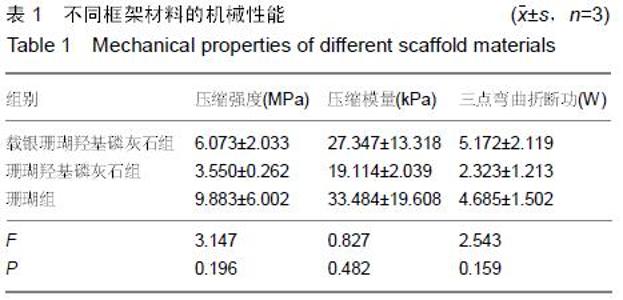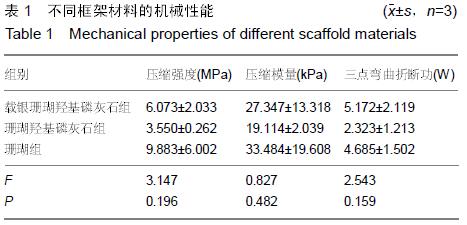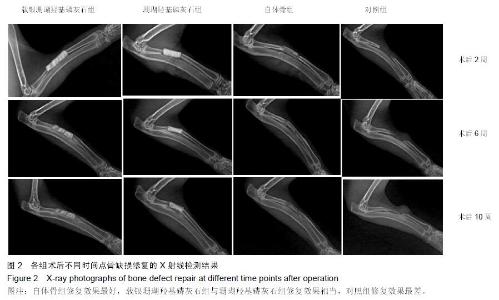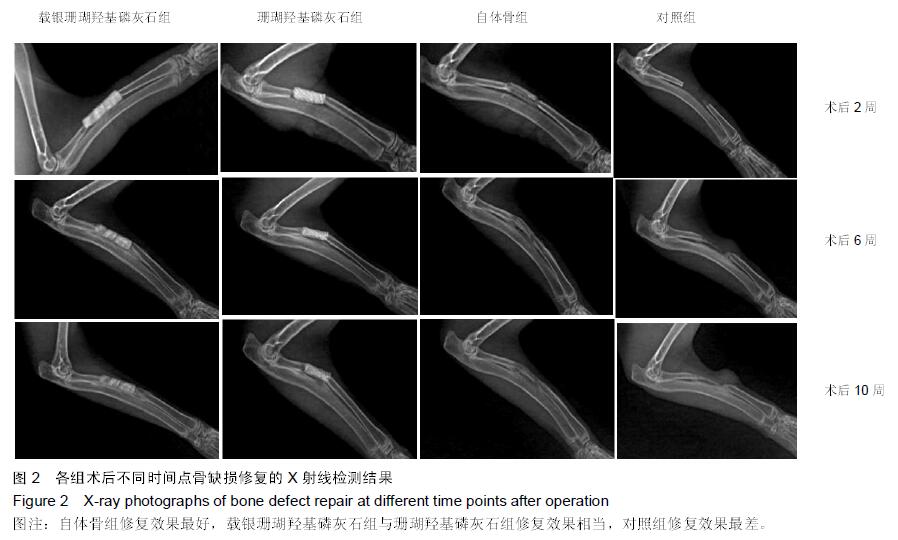Chinese Journal of Tissue Engineering Research ›› 2015, Vol. 19 ›› Issue (47): 7567-7574.doi: 10.3969/j.issn.2095-4344.2015.47.005
Previous Articles Next Articles
Mechanical property of silver-loaded coralline hydroxyapatite bone in the repair of large segmental contaminative radial defects
Zhang Yu, Yin Qing-shui, Zhang Yu
- Hospital of Orthopedics, Guangzhou General Hospital of Guangzhou Military Command of PLA, Guangzhou 510010, Guangdong Province, China
-
Received:2015-08-24Online:2015-11-19Published:2015-11-19 -
About author:Zhang Yu, M.D., Attending physician, Hospital of Orthopedics, Guangzhou General Hospital of Guangzhou Military Command of PLA, Guangzhou 510010, Guangdong Province, China -
Supported by:the National Key Basic Research Program (973 Program) of China, No. 2012CB619106; the Army “Twelfth Five-Year” Science and Technology Projects of China, No. CWS11C268; the Scientific and Technological Projects of Guangdong Province of China, No. 2003C104004, 2004B33101005
Cite this article
Zhang Yu, Yin Qing-shui, Zhang Yu. Mechanical property of silver-loaded coralline hydroxyapatite bone in the repair of large segmental contaminative radial defects[J]. Chinese Journal of Tissue Engineering Research, 2015, 19(47): 7567-7574.
share this article
| [1] 尹庆水,张余,李兆麟,等.复合珊瑚羟基磷灰石人工骨的研制和临床应用[J].骨与关节损失杂志,2003,18(3):147-149. [2] 徐晔,王大志,汤洪高,等.珊瑚水热转换羟基林磷灰石中的影响因素[J].化学物理学报,2001, 14(3):340-343.
[3] Liao SS,Cui FZ,Zhang W,et al.Hierarchically biomimetic bone scaffold materials: nano-HA/collagen/PLA composite.J Biomed Mater Res B Appl Biomater.2004;69(2):158-165.
[4] Yoneda M,Terai H,Imai Y,et al.Repair of an intercalated long bone defect with a synthetic biodegradable bone-inducing implant.Biomaterials.2005;26(25):5145-5152.
[5] Kokubo S,Fujimoto R,Yokota S,et al.Bone regeneration by recombinant human bone morphogenetic protein-2 and a novel biodegradable carrier in a rabbit ulnar defect model. Biomaterials.2003;24(9):1643-1651.
[6] Zhang Y,Yin QS,Zhang Y,et al.Determination of antibacterial properties and cytocompatibility of silver-loaded coral hydroxyapatite.J Mater Sci Mater Med.2010; 21(8): 2453-2462.
[7] Gibson LJ.The mechanical-behavior of cancellous bone.J Biomech.1985;18(5): 317-328.
[8] 朱明华,杨成民.植入性高分子材料的组织病理学观察[J].北京生物医学工程,1991,10(2):10217.
[9] Tan W,Krishnaraj R,Desai TA.Evaluation of nanostructured composite collagen-chitosan matrices for tissue engineering. Tissue Eng.2001;7(2):203-210.
[10] Rosenberg L. Chemical basis for the histological use of safranin O in the study of articular cartilage. J Bone Joint Surg Am,1971,53(1):69-82.
[11] Zhao G, Stevens SE Jr. Multiple parameters for the comprehensive evaluation of the susceptibility of Escherichia coli to the silver ion. Biometals. 1998;11(1): 27-32.
[12] Kim TN,Feng QL,Kim JO,et al.Antimicrobial effects of metal ions (Ag+、Cu2+、Zn2+)in hydroxyapatite.J Mater Sci Mater Med.1998;9(3):129-134.
[13] Kakinuma H,Ishii K,Ishihama H,et al.Antibacterial polyetheretherketone implants immobilized with silver ions based on chelate-bonding ability of inositol phosphate: processing, material characterization, cytotoxicity, and antibacterial properties. J Biomed Mater Res A.2015;103(1): 57-64.
[14] Noda I,Miyaji F,Ando Y,et al.Development of novel thermal sprayed antibacterial coating and evaluation of release properties of silver ions.J Biomed Mater Res B Appl Biomater. 2009;89(2):456-465.
[15] Honda M,Kawanobe Y,Ishii K,et al.In vitro and in vivo antimicrobial properties of silver-containing hydroxyapatite prepared via ultrasonic spray pyrolysis route.Mater Sci Eng C Mater Biol Appl.2013;33(8):5008-5018.
[16] Ma R,Tang S,Tan H,et al.Preparation,characterization, and in vitro osteoblast functions of a nano-hydroxyapatite/ polyetheretherketone biocomposite as orthopedic implant material.Int J Nanomedicine. 2014;9:3949-3961.
[17] Uhm SH,Song DH, Kwon JS,et al.Tailoring of antibacterial Ag nanostructures on TiO2 nanotube layers by magnetron sputtering.J Biomed Mater Res B Appl Biomater. 2014;102(3): 592-603.
[18] Gopi D,Shinyjoy E,Kavitha L.Synthesis and spectral characterization of silver/magnesium co-substituted hydroxyapatite for biomedical applications.Spectrochim Acta A Mol Biomol Spectrosc.2014;127:286-291.
[19] Han CM,Jang TS,Kim HE,et al.Creation of nanoporous TiO2 surface onto polyetheretherketone for effective immobilization and delivery of bone morphogenetic protein.J Biomed Mater Res A. 2014;102(3):793-800.
[20] Barkarmo S,Andersson M,Currie F,et al.Enhanced bone healing around nanohydroxyapatite-coated polyetheretherketone implants: An experimental study in rabbit bone.J Biomater Appl.2014;29(5):737-747.
[21] Ruan H,Liu J,Fan C,et al.Experimental research in vitro on antibacterial property and biocompatibility of silver-containing hydroxyapatite coating.Zhongguo Xiu Fu Chong Jian Wai Ke Za Zhi.2009;23(2):226-230.
[22] Yoshida K,Tanagawa M,Atsuta M.Characterization and inhibitory effect of antibacterial dental resin composites incorporating silver-supported materials.J Biomed Mater Res. 1999;47(4):516-522.
[23] Verne E,Di Nunzio S,Bosetti M,et al.Surface characterization of silver-doped bioactive glass. Biomaterials.2005;26(25): 5111-5119.
[24] Mann RJ,Blount AL,Neaman KC,et al.Mimix hydroxyapatite cement use in the reconstruction of the craniofacial skeleton.J Craniofac Surg.2011;22(6):2144-2147.
[25] Park JW,Kim JM,Lee HJ,et al.Bone healing with oxytocin-loaded microporous β-TCP bone substitute in ectopic bone formationmodel and critical-sized osseous defect of rat.J Clin Periodontol.2014;41(2):181-190.
[26] Cosson S,Otte EA,Hezaveh H,et al. Concise review: tailoring bioengineered scaffolds for stem cell applications in tissue engineering and regenerative medicine. Stem Cells Transl Med. 2015;4(2):156-164. |
| [1] | Xu Feng, Kang Hui, Wei Tanjun, Xi Jintao. Biomechanical analysis of different fixation methods of pedicle screws for thoracolumbar fracture [J]. Chinese Journal of Tissue Engineering Research, 2021, 25(9): 1313-1317. |
| [2] | Zhang Tongtong, Wang Zhonghua, Wen Jie, Song Yuxin, Liu Lin. Application of three-dimensional printing model in surgical resection and reconstruction of cervical tumor [J]. Chinese Journal of Tissue Engineering Research, 2021, 25(9): 1335-1339. |
| [3] | Chen Xinmin, Li Wenbiao, Xiong Kaikai, Xiong Xiaoyan, Zheng Liqin, Li Musheng, Zheng Yongze, Lin Ziling. Type A3.3 femoral intertrochanteric fracture with augmented proximal femoral nail anti-rotation in the elderly: finite element analysis of the optimal amount of bone cement [J]. Chinese Journal of Tissue Engineering Research, 2021, 25(9): 1404-1409. |
| [4] | Zhou Jihui, Li Xinzhi, Zhou You, Huang Wei, Chen Wenyao. Multiple problems in the selection of implants for patellar fracture [J]. Chinese Journal of Tissue Engineering Research, 2021, 25(9): 1440-1445. |
| [5] | Zeng Yanhua, Hao Yanlei. In vitro culture and purification of Schwann cells: a systematic review [J]. Chinese Journal of Tissue Engineering Research, 2021, 25(7): 1135-1141. |
| [6] | Xu Yulin, Shen Shi, Zhuo Naiqiang, Yang Huilin, Yang Chao, Li Yang, Zhao Heng, Zhao Lu. Biomechanical comparison of three different plate fixation methods for acetabular posterior column fractures in standing and sitting positions [J]. Chinese Journal of Tissue Engineering Research, 2021, 25(6): 826-830. |
| [7] | Cai Qunbin, Zou Xia, Hu Jiantao, Chen Xinmin, Zheng Liqin, Huang Peizhen, Lin Ziling, Jiang Ziwei. Relationship between tip-apex distance and stability of intertrochanteric femoral fractures with proximal femoral anti-rotation nail: a finite element analysis [J]. Chinese Journal of Tissue Engineering Research, 2021, 25(6): 831-836. |
| [8] | Song Chengjie, Chang Hengrui, Shi Mingxin, Meng Xianzhong. Research progress in biomechanical stability of lateral lumbar interbody fusion [J]. Chinese Journal of Tissue Engineering Research, 2021, 25(6): 923-928. |
| [9] | Xie Chongxin, Zhang Lei. Comparison of knee degeneration after anterior cruciate ligament reconstruction with or without remnant preservation [J]. Chinese Journal of Tissue Engineering Research, 2021, 25(5): 735-740. |
| [10] | Xu Dongzi, Zhang Ting, Ouyang Zhaolian. The global competitive situation of cardiac tissue engineering based on patent analysis [J]. Chinese Journal of Tissue Engineering Research, 2021, 25(5): 807-812. |
| [11] | Wu Zijian, Hu Zhaoduan, Xie Youqiong, Wang Feng, Li Jia, Li Bocun, Cai Guowei, Peng Rui. Three-dimensional printing technology and bone tissue engineering research: literature metrology and visual analysis of research hotspots [J]. Chinese Journal of Tissue Engineering Research, 2021, 25(4): 564-569. |
| [12] | Chang Wenliao, Zhao Jie, Sun Xiaoliang, Wang Kun, Wu Guofeng, Zhou Jian, Li Shuxiang, Sun Han. Material selection, theoretical design and biomimetic function of artificial periosteum [J]. Chinese Journal of Tissue Engineering Research, 2021, 25(4): 600-606. |
| [13] | Liu Fei, Cui Yutao, Liu He. Advantages and problems of local antibiotic delivery system in the treatment of osteomyelitis [J]. Chinese Journal of Tissue Engineering Research, 2021, 25(4): 614-620. |
| [14] | Li Xiaozhuang, Duan Hao, Wang Weizhou, Tang Zhihong, Wang Yanghao, He Fei. Application of bone tissue engineering materials in the treatment of bone defect diseases in vivo [J]. Chinese Journal of Tissue Engineering Research, 2021, 25(4): 626-631. |
| [15] | Zhang Zhenkun, Li Zhe, Li Ya, Wang Yingying, Wang Yaping, Zhou Xinkui, Ma Shanshan, Guan Fangxia. Application of alginate based hydrogels/dressings in wound healing: sustained, dynamic and sequential release [J]. Chinese Journal of Tissue Engineering Research, 2021, 25(4): 638-643. |
| Viewed | ||||||
|
Full text |
|
|||||
|
Abstract |
|
|||||



















